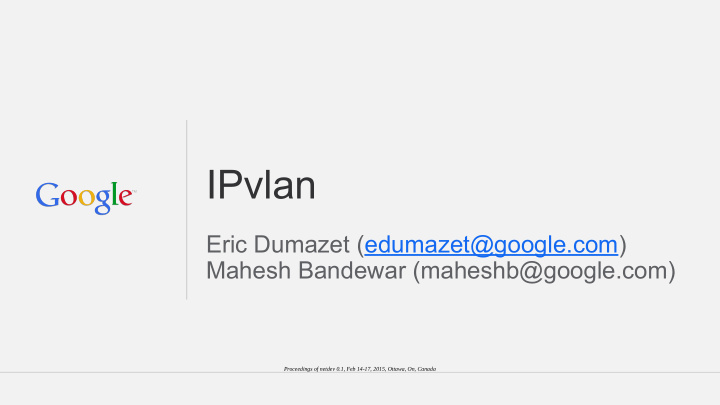



IPvlan Eric Dumazet (edumazet@google.com) Mahesh Bandewar (maheshb@google.com) Proceedings of netdev 0.1, Feb 14-17, 2015, Ottawa, On, Canada
IPvlan (instead of MACvlan) : Why? ● Switches may apply policies to disable CAM-table overflow essentially allowing a mac-address per incoming frame per port ● Excessive use of mac-addresses per NIC on host may put the host in promiscuous mode. ○ Might have impact if the connected switch starts throwing all multicast traffic as well. ● Other alternatives are not really well performing ○ NAT ○ Forwarding Proceedings of netdev 0.1, Feb 14-17, 2015, Ottawa, On, Canada
IPvlan: Development Challenges, Choices ● Integrate changes into macvlan itself ○ Proved difficult without any compromises ● Broadcast / Multicast tweaks ○ Turn-off broadcast if IPv4 is not used. ○ Use multicast filter in decision making while forwarding to slave ● Communication with Master (mostly in init_ns ) ○ macvlan solves this with hairpin-mode support from connected switch ○ IPvlan can’t do this (same L2 address)! Proceedings of netdev 0.1, Feb 14-17, 2015, Ottawa, On, Canada
IPvlan: Development Challenges, Choices (continue…) ● To communicate with host the setup need to put host on the same IPvlan bridge as rest of the slaves. ● Alternatively there are patches to the stack to inject routes in the master’s namespace to redirect packets. These were viewed as too intrusive. Proceedings of netdev 0.1, Feb 14-17, 2015, Ottawa, On, Canada
IPvlan: Use Cases ● IPvlan in L2 mode [slave(s) assigned to namespace(s)] ○ Setup is similar to several hosts connected to an external switch. ○ This is very similar to macvlan bridge mode. ○ Each slave can operate on it’s own [IP, routing etc.] ○ Suited in trusted environment. ● IPvlan in L3 mode [slave(s) assigned to namespace(s)] ○ All slaves receive only unicast. Master handles rest. ○ Each slave relies on the routing from the masters’ namespace. ○ Tinkering with IP inside namespace may lose connectivity. ○ Suited in non-trusted environment. Proceedings of netdev 0.1, Feb 14-17, 2015, Ottawa, On, Canada
IPvlan: Performance comparison Proceedings of netdev 0.1, Feb 14-17, 2015, Ottawa, On, Canada Google Confidential and Proprietary
IPvlan: Future Enhancements ● Defer multicast / broadcast traffic processing. ○ Deferring will boost unicast throughput and improve latencies ○ Doesn’t need to process these in fast-path. ● ARP filters. ○ Applicable to IPv4 only ○ Probe into the ARP and forward only when slave may have interest. ○ Will save on packet duplication when slaves are many. ● Tap type slave device interface for Kvm/Qemu. ○ Similar to macvtap Proceedings of netdev 0.1, Feb 14-17, 2015, Ottawa, On, Canada
IPvlan: Future Enhancements (continue…) ● Offload XMIT to hardware if NIC supports it. ○ Similar to few current Intel NICs for macvlan. ○ Can’t use just L2 and logic needs to include L3 (possibly more?) ● Enhanced L3 mode to enable communication with master. ○ L3 mode does not deal with broadcast and multicast. ○ If master has to communicate with other slave, then should use same bridge. ○ Nominate one of the slaves to receive broadcast / multicast ● Userspace support ○ Docker ○ CRIU Proceedings of netdev 0.1, Feb 14-17, 2015, Ottawa, On, Canada
IPvlan: Questions? Comments? Proceedings of netdev 0.1, Feb 14-17, 2015, Ottawa, On, Canada
More recommend